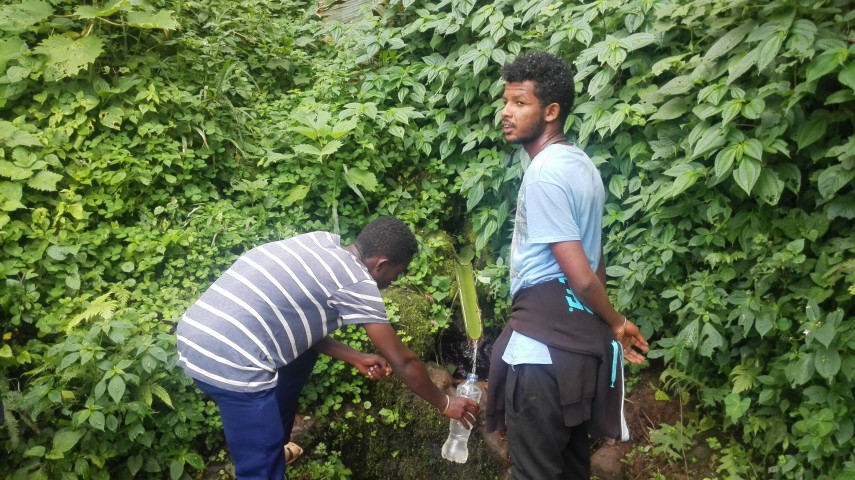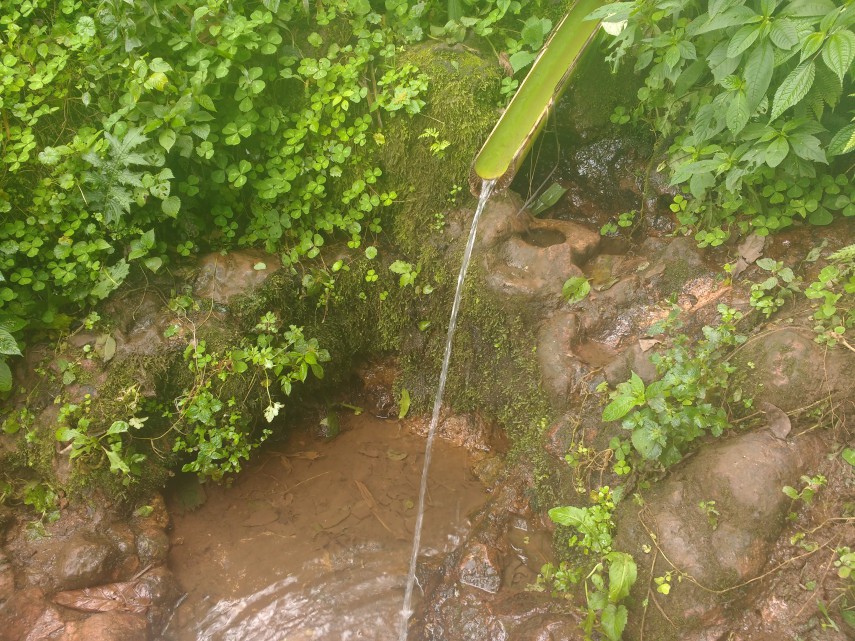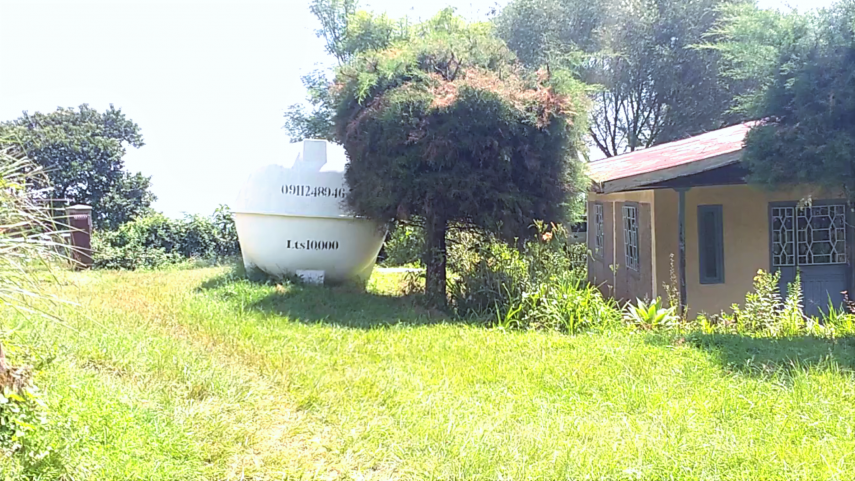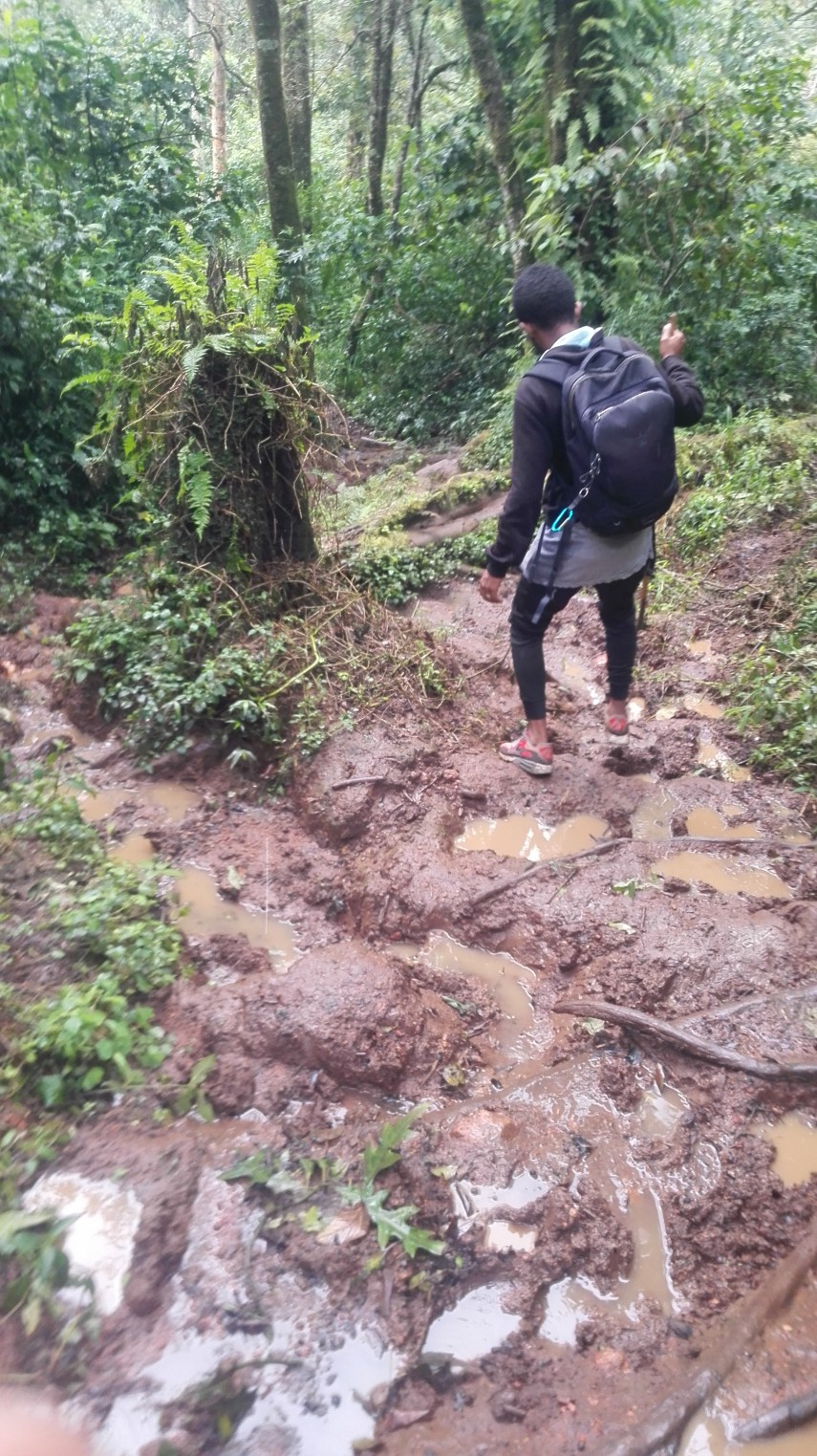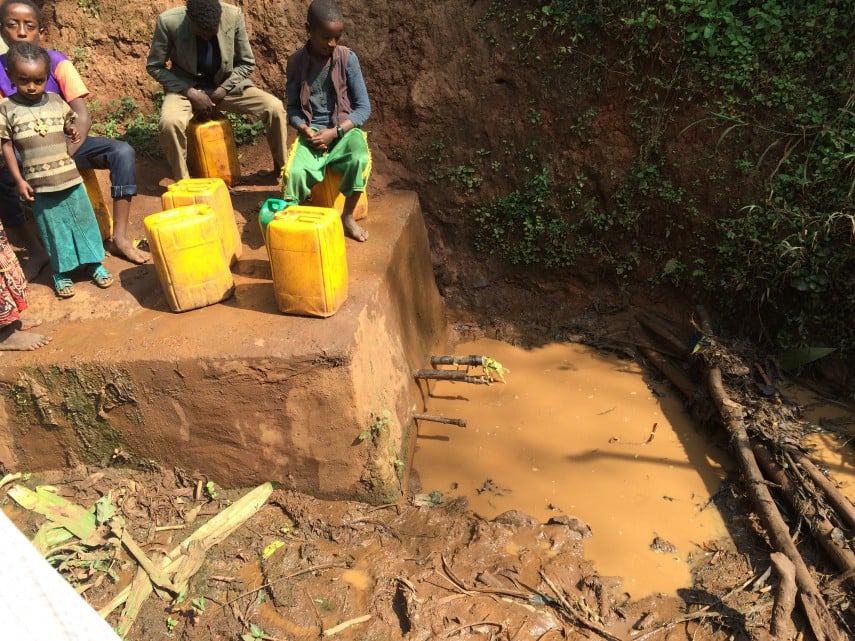Why Is There No Water? by Selam G. '18
One of the most important things in your life is invisible to you until it disappears.
A lot of people living in the United States don’t understand how complicated water is. I created this post as a sort of quick-guide to water, and the complexity of getting water to places that don’t have it.
I was inspired to write this post by a tumblr question I received while in Ethiopia this summer. I feel like it pretty much embodies all the questions I’ve ever been asked about the water project that I’ve been working on (you can read more about that here if you want!)

For context, Muti is the village in Kaffa, Ethiopia where I’ve been doing the water project.
Let’s break down this question into a few topics. First, what does “no water” mean? Second, what about natural water options such as rain, streams, and rivers? Third, how do people “get” water? And lastly, this question wasn’t asked, why is it important to have water?
“No Water”
A spring in Warwara, Kaffa, where residents walk to collect drinking water. It is unprotected and naturally purified (like a naturally clean mountain spring). My two cousins collect water from it in a plastic bottle to take home.
First, “no water,” of course, is a relative term. Obviously there’s some kind of water somewhere if there are people living there, because that’s one of the requirements for us to just physically be alive and things. There is no one living in the middle of the driest parts of the Sahara for this reason—that’s maybe one of very few places that literally has no water. When you or I or even people living in Addis Ababa (the capital city of Ethiopia) might mean when we say, “there is no water” is that the water from our faucets has stopped running for some reason, maybe because a water bill went unpaid or there’s a problem with the water pipes for the area or someone’s doing plumbing maintenance in the building.
When people in the rural areas of Kaffa say a place has “no water”, they mean there are no major clean or human-influenced water features. People in a region with “no water” are drinking/washing/living out of ponds, streams, lakes, etc. Some might have rain bins if it’s a rainy place, but that’s typically not enough and also still quite unclean. Many homes or communities have small, shared wells: hand-dug wells that 4-5 houses share between them for non-drinking uses. Often, the shared shallow wells are too shallow to have water year-round (typically drying out in the dry season) and the digging of these wells can be a very dangerous operation. Muti and the Kaffa region overall gets a ton of rain, which is great because we don’t have to worry about water for crop irrigation. But, there’s still “no water” for people to drink, cook, or wash with in many places there.
Rain
A (broken) roto tank used to collect rainwater in Wushwush, sitting in the front yard waiting to be fixed.
I’ve been surprised, while telling people about this project, at how little people seem to understand rain and its effects on drinking water. I later realized that the issues with rain were only intuitive to me because of the summers I myself spent in Kafa, visiting and living with our family, collecting water from the river.
Rain itself not clean!!! A lot of people immediately ask about rain collection methods when I say Kaffa is a very rainy place, because they think rain must be clean and so rain collection might be an easy, obvious solution. In actuality, rain collects dust particles as it falls through the air, and in an almost tropical, forest-environment such as Kafa’s, rainstorms kick up a lot of dirt and bugs and leaves that are just as likely to get into a rain bin as the water—the larger the container, the more likely contaminants will enter. Water collected in a large enough container also becomes stagnant when the rain stops, which even in a matter of days breeds bacteria and mosquitos and can actually become much worse than running river water. So, you can’t just have a giant rain collector without any filtering or covering or some more complicated structure as a solution. Rain collection is a type of solution to water issues that lots of people work on researching, but my point is, it’s not as though you can simply buy a very large bin and solve everyone’s problems. Where people do use rain bins in Kafa, they are relatively small, the size (as I said) being limited by potential contaminants or the effects of stagnating. People also do not typically use this rainwater for drinking or cooking—they would actually prefer to use the water fetched from the river for that.
Another surprising point about rain is that rainstorms actually cause water problems, especially in rivers and especially in forest environments. For example, let’s say there’s only one water source for a 5-mile radius, a river. After a storm, the river might swell. When the river swells, it will flood the banks slightly and bring into the river all the dirt and plants and bugs and debris that lives/rests on the bank of the river. The increase in water flow will also kick up the sediment at the bottom of the river. The river, in short, actually becomes dirtier than it was before because of the rain. And how much dirtier it becomes depends on how big the rainstorm was. Even by the standards of people living in Kafa, the water after a really big storm can become undrinkable, impossible to boil or process—you will dip a cup or container into the river and get a muddy, viscous mixture of water, sand, and dirt because of the swell. It can take days for the effects of a large enough swell to pass.
I remember this actually happening to me once, when I was visiting my family in our village, Warwara, which didn’t have any water when I was a kid. It had rained the day before. I went with my cousins to fetch water, and the usual bank where we fill the containers was muddy and thick with debris. We had to walk a bit along the river to find a cleaner spot, and the water we collected was still visibly cloudier than before.
So rain, on its own, is not as pure and life-giving as some might think.
Rivers, Streams, and Lakes, Oh My!
The “road” through the forest. During the rainy season, it looks like this, and residents travel on paths such as these to simply get from point A to point B, including to collect water (which means returning with heavy containers)
Besides issues with rain, there are several other problems with surface water such as rivers, streams, and lakes. From the perspective of residents of Kaffa, the biggest issue with surface water is accessibility. There are not typically 5 rivers in a 5-mile radius, or a river that conveniently loops around every mile—there’s just one river, and how accessible it is depends on how far you live from it. Rivers are also often in valleys or the sides of hills, difficult to even walk up or down to. Many places in the region now “have water” simply because a ground pipe system was implemented to distribute the river water throughout the town. The pipes simply operate via pressure and gravity—smaller pipe widths provide enough pressure to “push” water uphill when a larger volume is fed into it.
Ponds and lakes (well, there aren’t really any lakes in Kaffa) are not considered drinkable water—the people are aware of the many, many problems of stagnant water. And it’s not hard to tell if water is unfit for use, as any ponds in the area are typically blanketed with algae and unpleasant growth anyway.
When we talk about distance in cities like Addis Ababa or Boston, we might say “30 minutes on the T” or “2 taxis away” or “15 minutes by car”. When we talk about distance in Kaffa, it is always in terms of walking. It’s not even that people don’t have cars—there aren’t even roads that cars could drive on. 5 miles, therefore, is a lot more in Kaffa than it is in Boston or Addis Ababa.
How do people “get” water?
I was surprised and confused the most by the part of this question that said, “what is preventing Muti from having water?” To me, that’s like saying, “what is preventing Muti from having a skyscraper?” Hopefully it’s become clear from the rest of this article that “having water” means having a human-influenced structure, as it’s difficult to subsist off of natural resources. So, the issue is not so much that something is “preventing” Muti from having water, it’s more like, well, who’s going to create the water structure? Where does it come from? How much does it cost? How much time will it take—and how much time will it last? When we build anything, it is a constant battle to keep it working properly (my fellow Course 2’s know this fact well).
I find it so interesting that this person used the word “preventing”—to me, it shows how in many places, we take water for granted. There is only “no water” because of an exceptional event—maintenance, unpaid bills, a grid failure. Something has to happen in order for the water to disappear. In Kaffa, the reverse is true—something has to happen for the water to be there.
We know so little about how our utilities get to us—in fact, I can say with certainty that I know way more about the water situation in Kaffa than in Boston. How does water get to my bathroom faucet in New House? I have no idea where it comes from or from how far away—the Charles River, a reservoir, a filtering plant? Are the pipes directly beneath the building? Is there a hydraulic or electric system in place to pump it up four floors to where I live? What’s the ultimate sink—does it get drained into the Charles River, a reservoir, a filtering plant?
Do you know where your water comes from? Do you even know how the water gets from the tank in your basement to your bathroom, just within your own house?
Our water systems in the United States are vast and complex and work very well—but this also makes them invisible to us, so maybe when we hear about lacking water in other places, it is difficult to understand. I think it shows very well how having a privilege is not necessarily a concrete advantage that we can see or think about, it’s the privilege to not see or not think about so many things. Having a privilege or advantage can be the lack of certain suffering rather than the presence of wealth or status, which makes it so much more difficult to detect.
Though our US water systems are vast and complex, that doesn’t mean that simpler infrastructure is cheap. As an immediate point of reference, another village nearby called Agaroboshe implemented a gravity/groundpipe system, in which water was piped from a high-up river and distributed throughout the town. That project, which was essentially varying-width pipes and concrete, cost $42,000 USD. A spring protection, one of the most basic types of water structures (you basically cover a small stream, using concrete to create a small clean reservoir that’s filtered naturally by the sediment of the earth—“protecting” the spring) can cost around $3,000 USD. Our target price for a hand-dug well in Muti is around $6,000 USD, and that’s because a lot of people have been nice to us, supplying discounted labor and materials. We’re also intentionally trying to design a cost-effective structure. And when I say “hand-dug”, it only means the actual hole-in-the-ground part is dug by hand and without a bore-hole machine. The well is still constructed with concrete and rebar and all that; that’s what’s needed for it to be a clean drinking water well.
….and why is this all important?
A broken spring protection in Muti. We are trying to solve the issue of spring protections failing too quickly (between 3 months to 3 years) in Muti by trying a different solution, a hand-dug well.
Here is what I found during the process of doing market research (which really just means, asking the same questions to lots and lots of people) in Muti:
- Children (as young as 5) are the ones who fetch water from rivers and streams. They can have lifetime health problems afterward from carrying the heavy containers back and forth.
- People regularly die digging shared, shallow water wells either from collapses or lack of oxygen.
- People (children) have died or gotten injured from falling into said shallow wells (fortunately, not as often anymore because people are aware of this problem now and small children are not sent to fetch water from wells)
- During the rainy season, there’s an increase of typhus/typhoid infection due to the rain and river-swelling problems I discussed earlier
I’m trying to also find (and prove, because I think it’s prove-able) correlations between education and socioeconomic status with water availability in rural Ethiopian towns and villages by looking at some regional data. Water is a really pervasive elements of our lives that we don’t even notice here in the US or (insert-industrial/developed-nation-here). Our society would collapse instantly if somehow, the water situation in the US was magically switched with Ethiopia’s. Coming back from this trip, I almost wondered if I should start awareness campaigning, because although xyz celebrity can get on a stage and talk about fundraising for water, I feel that there’s been little focus on actually educating others on how really, truly important and complex it is, and just how much it affects literally human being in the whole world. Period. I can use the phrase “affects literally every human being in the whole world” and have that sentence you just read be a true, factual statement.
So, I hope this post has given you some more insight into the basics of water! Water itself is simple, but the process of acquiring it, particularly clean, drinkable water, is far from an easy task.
